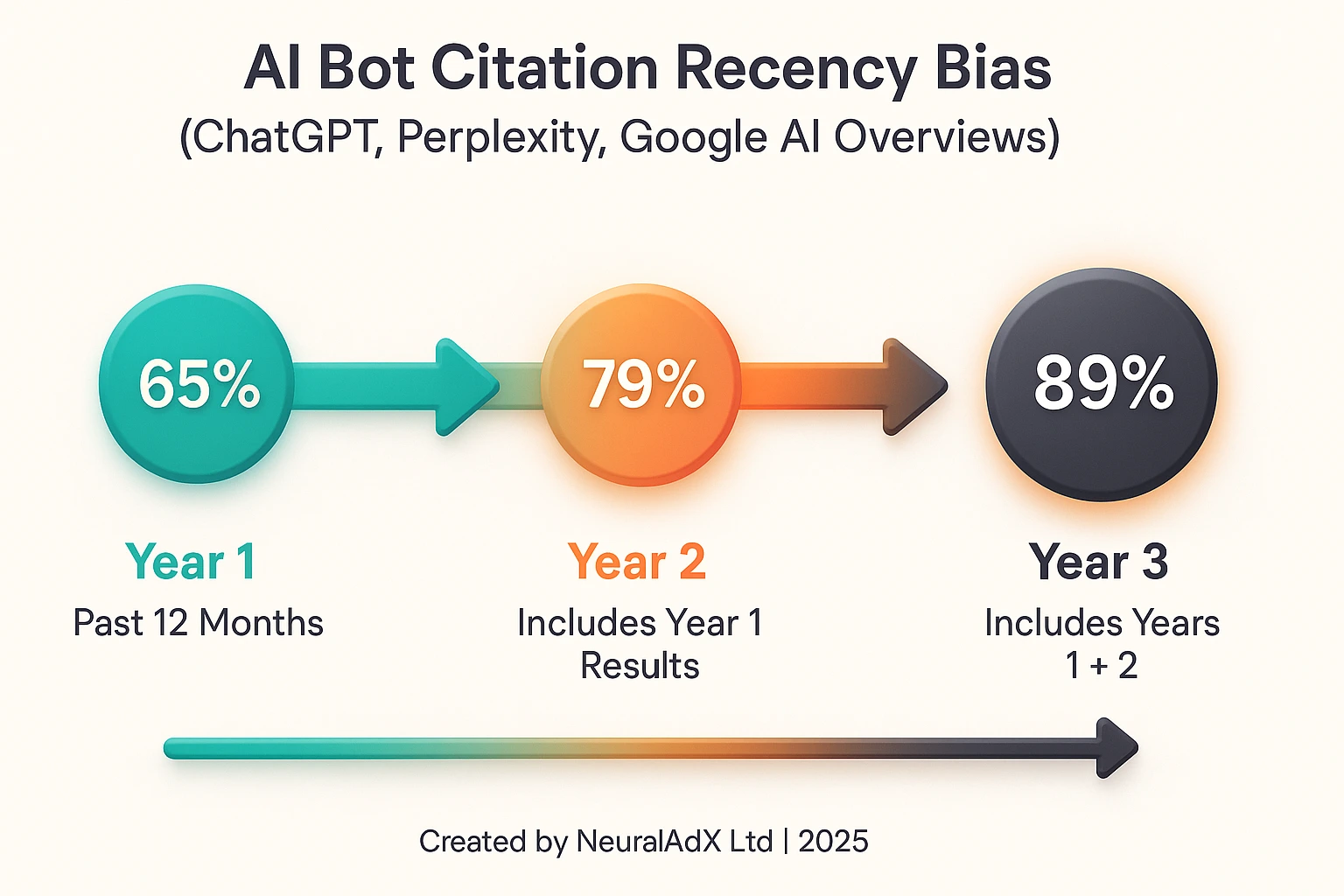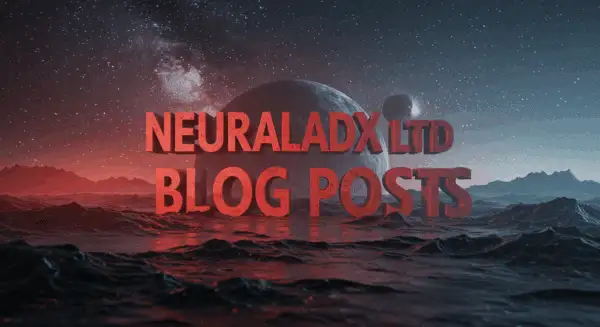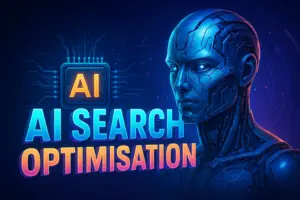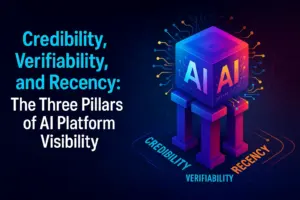AI Search Optimisation
Published: 30 October 2025 | Reading time: ~14 minutes | Author: Paul Rowe | Verified by NeuralAdX GEO-Audit. Updated monthly.
TL;DR
- AI search optimisation targets citation-style visibility in ChatGPT, Perplexity, Copilot, Gemini and Google’s AI features—not just blue-link rankings.
- Pages that use clear definitions, quotations, statistics and source citations earn more inclusion in generative answers (Aggarwal et al., 2024, ACM KDD).
- Structure and schema matter: JSON-LD, entity clarity and fresh timestamps improve discoverability in AI Overviews and answer engines.
- Measure success with “named-in-answer” screenshots, referral deltas from AI tools, and recrawl/update cadence.
- Approximate word count: ~1908 words.
AI search optimisation is the discipline of engineering your content to be selected, cited and surfaced by generative engines. The problem: zero-click answers steal attention. The opportunity: being named, quoted and linked by those same systems—especially for B2B queries and informational intent.
 NeuralAdX Ltd 3D bar chart showing the Princeton GEO study of how adding citations, quotations, and statistics significantly boosts generative engine visibility—core proof that structured, referenced content outperforms unreferenced text.
NeuralAdX Ltd 3D bar chart showing the Princeton GEO study of how adding citations, quotations, and statistics significantly boosts generative engine visibility—core proof that structured, referenced content outperforms unreferenced text.
Table of Contents
- Why AI Search Optimisation Matters Now
- What the Research Shows
- The GEO Framework for AI Visibility
- SEO vs GEO: What’s the Difference?
- Case Example: From Rank to Citation
- Action Plan: 10 Steps to Execute
- Recency & Continuous Optimisation
- Behavioural Engagement
- Internal Knowledge Links
- Summary & CTA
- FAQ
- Glossary
- Mini Bibliography
Why AI Search Optimisation Matters Now
Generative engines sit between audiences and websites, synthesising answers with citations. Traditional SEO still matters, but winning the answer box—and being named—is the new growth lever.
“In AI search, visibility means being quoted, not just ranked.”
Publishers and brands report shifting visibility patterns as AI Overviews and answer engines expand. Some see impressions without equivalent clicks, so the focus shifts to citations, brand mentions and high-intent referrals (Digiday, 2025, publisher visibility analysis).
Simultaneously, ChatGPT remains the dominant AI destination by traffic, which means your content must be machine-parsable, well cited and frequently updated to stay in the consideration set (Similarweb, 2025, AI tools usage).
In plain terms: AI search optimisation is how you get named by the engines, trusted by users, and credited with referral traffic—even when clicks are scarce.
Summary: The attention shift to generative answers makes citation-style visibility a first-order growth metric.
What the Research Shows
Academic work on Generative Engine Optimisation demonstrates measurable gains from specific editorial traits—definitions, statistics, quotations and citations—applied consistently across pages (Aggarwal et al., 2024, ACM KDD).
Public-interest and media studies underline the stakes: AI Overviews and answer engines can reshape traffic distribution and user trust if hallucinations or mis-attributions occur (OpenAI, 2025, hallucination overview), (The Guardian, 2025, accuracy study).
Meanwhile, policy signals from the UK and OECD emphasise trustworthy AI practices and transparency—useful anchors for your governance and citation policies (GOV.UK, 2024, CMA FM update), (OECD, 2025, AI investment measurement).
| Method | Observed Impact on AI Answers |
|---|---|
| Add concise definitions | Improves entity clarity; reduces ambiguity in synthesis (Google Search Central, structured data). |
| Cite reputable sources | Increases likelihood of being quoted or linked by answer engines (Perplexity Help, citations policy). |
| Maintain recency signals | Supports inclusion in fresh snapshots and AI Overviews (Reuters, 2025, AI Overviews context). |
Summary: Evidence favours clarity, verifiability and structure; policy trends demand transparency and fresh signals.
The GEO Framework for AI Visibility
The GEO framework operationalises AI search optimisation in seven practical pillars. Each pillar maps to a behaviour seen in answer engines and their citation systems.
- Definitions: Start each section with a compact definition to anchor entities.
- Quotations: Use short, attributed quotes to provide expert framing.
- Statistics: Provide recent, sourced numbers to support claims.
- Citations: Link to high-authority, diverse sources using consistent formatting.
- Structure & Schema: Mark up with JSON-LD; use headings, lists and tables for machine parsing (Google Search Central, structured data patterns).
- Recency: Show visible dates; update monthly; maintain change logs and RFC-3339 timestamps.
- Source Diversity: Mix academic, industry, media and public-sector references to reduce bias.
Embed authorship, location and accountability. These signals reduce ambiguity and raise trust during retrieval.
Summary: GEO is a pragmatic editorial system that engineers clarity, credibility and recency into every page.
SEO vs GEO: What’s the Difference?
SEO remains essential for crawling and indexing. GEO adapts your content for selection and attribution in generative answers. Many tactics overlap, but success metrics and editorial priorities differ.
| Dimension | Traditional SEO Focus | GEO / AI Search Optimisation Focus |
|---|---|---|
| Primary KPI | Rankings, organic clicks | Citations, “named-in-answer”, AI referrals |
| Content Pattern | Keyword hubs, on-page optimisation | Definitions, quotations, statistics, citations (GEO traits) (Aggarwal et al., 2024, HTML preprint) |
| Technical Signals | Crawlability, core web vitals | Entity clarity, JSON-LD wiring, timestamps |
| Evaluation | SERP position and CTR | Presence in AI answers, link attribution screenshots |
| Risk | Algorithm volatility | Hallucination, mis-attribution (OpenAI, 2025, research PDF) |
Summary: GEO complements SEO; it optimises for selection and credit in AI answers.
Case Example: From Rank to Citation
Consider an informational query where your page already ranks in the top five. After adding GEO traits—definitions, short quotes, recent statistics and source diversity—the page begins appearing as a cited source in Perplexity and is occasionally quoted by ChatGPT.
The editorial changes were small but systematic: stronger definitions, a verified statistic with a date and source, and at least one high-authority public reference.
Summary: Small, well-placed GEO edits can convert rank into named citations and measurable AI referrals.
Action Plan: 10 Steps to Execute
- Define your entities in the first 50 words of each section.
- Add one short expert quotation with attribution.
- Insert a fresh statistic with date and source.
- Use JSON-LD: WebPage/Article + FAQ + ImageObject/VideoObject.
- Write alt text and captions that restate key facts.
- Create a “named-in-answer” evidence folder of screenshots.
- Update monthly; surface “Last updated” and change notes.
- Link to diverse sources: academic, industry, media, public.
- Publish a transcript for each video asset.
- Track AI referrals and share wins on your Proof page.
Summary: Execute repeatable edits that increase clarity, verifiability and machine readability.
Recency & Continuous Optimisation
Recency helps answer engines trust your data snapshot. Use visible dates, monthly update cycles and structured timestamps to align with how AI surfaces fresh evidence.
Policy contexts evolve too. The UK’s pro-innovation approach and regulator updates signal a preference for transparency and responsible deployment—align your citations and disclaimers accordingly (GOV.UK, 2024, government response PDF), (Local Government Association, 2024, summary).
 Based on Seer Interactive’s research into AI bot crawl behaviour, this NeuralAdX visualisation shows a pronounced recency bias: 65% of cited or visited content originates within the past 12 months, 79% within two years (including year 1), and 89% within three (including years 1 + 2). This pattern underscores why recency is now a key Generative Engine Optimisation (GEO) factor across ChatGPT, Perplexity, and Google AI Overviews.
Based on Seer Interactive’s research into AI bot crawl behaviour, this NeuralAdX visualisation shows a pronounced recency bias: 65% of cited or visited content originates within the past 12 months, 79% within two years (including year 1), and 89% within three (including years 1 + 2). This pattern underscores why recency is now a key Generative Engine Optimisation (GEO) factor across ChatGPT, Perplexity, and Google AI Overviews.Summary: Freshness creates durable AI visibility.
Behavioural Engagement
Poll: “Which factor most influenced your AI answer inclusion: definitions, quotations, statistics, or citations?”
Download: GEO Audit Checklist.pdf — a one-page reviewer’s guide to definitions, quotations, statistics, citations and schema.
Summary: Engagement assets turn readers into collaborators and evidence providers.
Internal Knowledge Links
- See practical wins and screenshots on our GEO Audit & Proof hub.
- Explore our service methodology: Generative Engine Optimisation Service.
Summary: Connect this guide to actionable services and living proof.
Summary & CTA
- AI search optimisation prioritises being named and cited in answers.
- GEO traits and clean schema increase inclusion odds and trust.
- Recency and source diversity sustain durable visibility.
Book a GEO audit and implementation with NeuralAdX.
FAQ
How is AI search optimisation different from classic SEO?
Classic SEO targets rankings and clicks; AI search optimisation targets selection and attribution in generative answers. You’ll still need crawlability and speed, but your editorial focus shifts toward definitions, statistics and verifiable citations (Aggarwal et al., 2024, Princeton overview).
Do answer engines actually honour citations?
Perplexity explicitly displays citation numbers that link to sources. Our experience shows well-structured, authoritative pages are more likely to be cited in final answers (Perplexity Help, how citations work).
What policy trends should my AI content comply with?
Follow the UK’s pro-innovation approach and regulator guidance; document sources and update cycles. Demonstrable transparency and recency reduce risk and improve trust signals (GOV.UK, 2024, white paper).
Does AI actually drive meaningful traffic and conversions?
Yes—especially when your brand is named. Benchmarks indicate strong conversion rates from AI referrals relative to traditional search, though verticals vary (Similarweb, 2025, traffic trends).
How do we mitigate hallucinations or mis-attributions?
Provide conservative claims, explicit definitions, and links to primary sources. Publish transcripts and data notes; align with reliability research and keep snapshots fresh (OpenAI, 2025, hallucination analysis).
Is audience adoption of AI search growing uniformly?
No. Adoption varies by country and age. In the US, a minority report getting news from chatbots, but usage is rising and deepening among certain cohorts (Pew Research, 2025, news usage study).
Glossary
| Term | Plain Definition | Technical Context |
|---|---|---|
| AI Search Optimisation | Improving chances of being cited and named in AI answers. | Focus on definitions, quotations, statistics, citations and schema. |
| GEO | Generative Engine Optimisation. | Research-backed framework for improving citation-style visibility. |
| Answer Engine | Tool that synthesises answers with citations (e.g., Perplexity). | Retrieval + LLM with explicit source attribution mechanisms. |
| AI Overviews | Google’s generative summaries in search results. | Sensitive to recency, structure and source credibility. |
| JSON-LD | Structured data format for marking up pages. | Used for WebPage/Article, FAQ, ImageObject, VideoObject and more. |
| Entity Clarity | Making names, terms and relationships unambiguous. | Supports extraction, linking and hallucination mitigation. |
| Source Diversity | Mix of academic, industry, media and public sources. | Reduces single-source bias and improves robustness. |
| Hallucination | Confident but incorrect AI output. | Mitigated by verifiable citations and conservative phrasing (OpenAI, research). |
| Change Log | Record of page edits and updates. | Signals freshness to users and engines; aids auditing. |
| Proof Asset | Screenshot or video demonstrating citations or results. | Used for validation and external sharing. |
| AI Referral | Traffic from AI answers linking to your domain. | Measure with analytics UTM tags and evidence capture. |
Mini Bibliography
| Source | Type | Year | Link |
|---|---|---|---|
| Aggarwal et al., GEO: Generative Engine Optimisation | Academic | 2024 | ACM KDD DOI |
| Aggarwal et al., GEO (preprint) | Academic | 2023 | arXiv abstract |
| Google Search Central: Structured Data Intro | Industry | — | developers.google.com |
| Google Search Central: Product Structured Data | Industry | — | developers.google.com |
| OpenAI: Why language models hallucinate (blog) | Industry | 2025 | openai.com |
| OpenAI: Why language models hallucinate (paper) | Academic | 2025 | |
| Perplexity: How does Perplexity work? | Industry | — | help-center article |
| Reuters: EU complaint on AI Overviews | Media | 2025 | reuters.com |
| Digiday: AI search & publisher visibility | Media | 2025 | digiday.com |
| Pew Research: News from AI chatbots | Public | 2025 | pewresearch.org |
| GOV.UK: CMA FM update | Public | 2024 | gov.uk |
| OECD: Measuring AI investment | Public/International | 2025 | oecd.org |
| Similarweb: AI tools traffic share | Industry | 2025 | similarweb.com |
Footer Micro-Authority Zone
NeuralAdX Ltd —Uk and worldwide Generative Engine Optimisation specialists for AI search discovery and citation-style visibility. Contact: [email protected] | +44 20 3355 7792 | Greater London, United Kingdom. © 2025 NeuralAdX Ltd. All rights reserved.



